Chapter 7 - Trade Finance
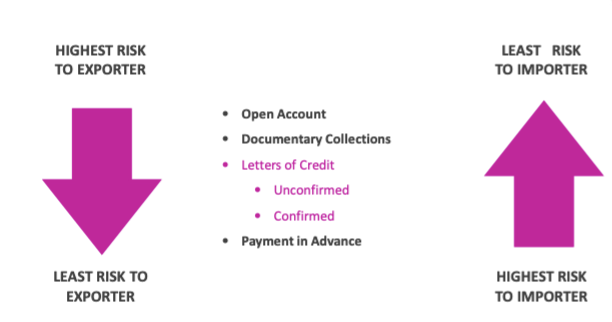
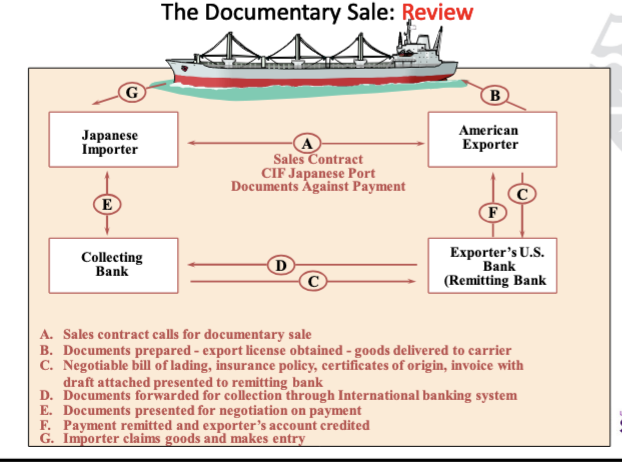
The Law of Negotiable Instruments: Drafts or Bills of Exchange
Facilitates payment: Act as a substitute for money (Exhibit 7.1)
Seller (Drawer) orders
Buyer (Drawee) to pay
a specified amount
at a specified time
Sight Draft – when presented
Time Draft – at a specified time
May be “order” or “bearer”
The Law of Negotiable Instruments
Bill of Exchange or Draft (US term) [Subject to different national laws]
Two purposes:
Substitute for money
Financing/Credit device
Negotiability is a matter of form
UCC Article 3
Instrument must:
Be in writing
Signed
Contain unconditional order or promise to pay
Fixed amount of money
No other undertaking
Payable on demand or specific time
Payable to order of a specific person or to bearer
Types of drafts
See example Exhibit 7.1
Sight draft – payable upon presentation or demand
Time draft – payable at a specified time
Review documentary collection process –
Draft part of the documents
Seller uses international banks in collection
Buyer [or Bank] pays according to draft when documents presented

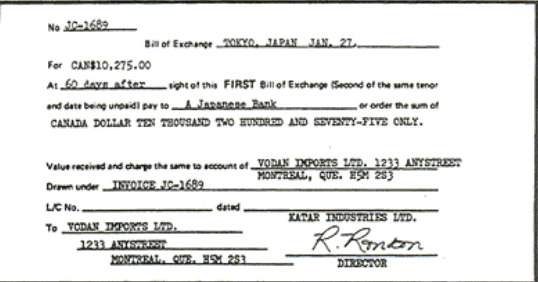
Banker’s Acceptance
Subject to Federal law in the US
Substitute a bank’s acceptance for that of a party
This is a term in the Sales Contract
When Bank Accepts, the bank becomes obligated to pay the amount to the holder on the date specified. See example Exhibit 7.1
How do you use drafts as financing device?
Seller gets the Accepted draft & can
Hold until it matures
Sell it at a discount
Contract term
Documents against payment [sight draft]
Documents against acceptance [time draft]
Concept of negotiation and transfer
Negotiability allows draft to be substitute for money
Negotiation = transfer of instrument from one party to a holder (transferee) so that holder gets legal rights
How do you negotiate?
Bearer instrument or
Order instrument
Letters of Credit
Written undertaking (contract) by the Importer’s bank, (Issuing Bank)
On behalf of its customer, the Buyer (Account Party), promising to pay the Seller (Beneficiary) up to a stated sum of money,
Within a prescribed time limit and
Against stipulated documents.
Conditional promise to pay
A Revocable Letter of Credit can be revoked without the consent of the Exporter, meaning that it may be canceled or changed up to the time the documents are presented. Revocable Letters of Credit are very rarely used.
An Irrevocable Letter of Credit cannot be canceled or amended without the consent of all parties including the Exporter. Unless otherwise stipulated, all Letters of Credit are irrevocable.
If payment is to be made at the time that documents are presented, this is referred to as a
SIGHT Letter of Credit.
(used with a sight draft)
If payment is to be made at a future fixed time from the presentation of documents, this is referred to as a
TERM or TIME Letter of Credit
(used with a time draft)
Mechanics: How does a Letter of Credit work?
Three steps
Issuance
Flow of Good
Flow of Documents & Payment
Three relationships
Bank & Buyer
Seller & Buyer
Bank & Beneficiary (Seller)
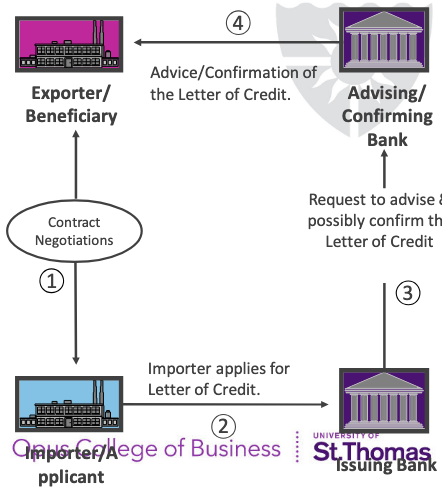
Letters of Credit: Issuance
Contract for sale of goods payment by Letter of Credit,
Buyer requests that its bank (Issuing Bank) issue a Letter of Credit in favor of the Seller (Beneficiary).
The Issuing Bank sends the LoC to the Advising Bank. Usually located in the country where the Exporter does business and may be the Exporter’s bank, but does not have to be.
The Advising/Confirming Bank verifies the Letter of Credit for authenticity and sends it to the Exporter.
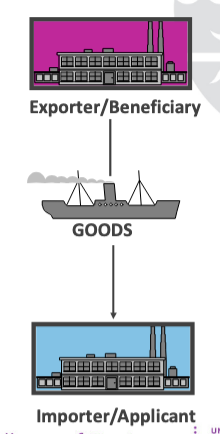
Letters of Credit: Flow of Goods
Exporter reviews LoC to ensure that it corresponds to the terms and conditions in the contract (documents stipulated in the LoC can be produced).
Assuming the Exporter is in agreement with the above, it arranges for shipment of the goods.
Includes the Negotiable Bill of Lading
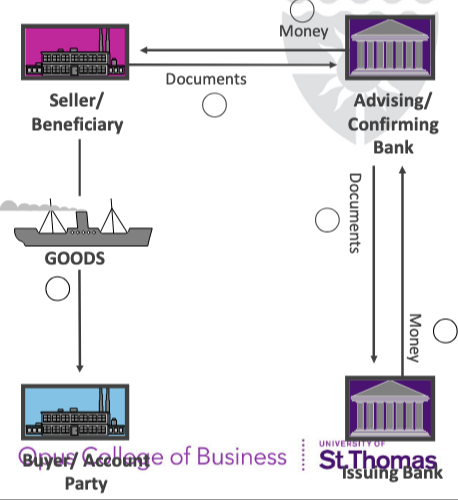
Letters of Credit: Flow of Documents & Payment
After the goods are shipped,
The Exporter presents the documents specified in the LoC to the Advising/ Confirming Bank.
Once the documents are checked and found to comply with the LoC the Advising/ Confirming Bank forwards these documents to the Issuing Bank.
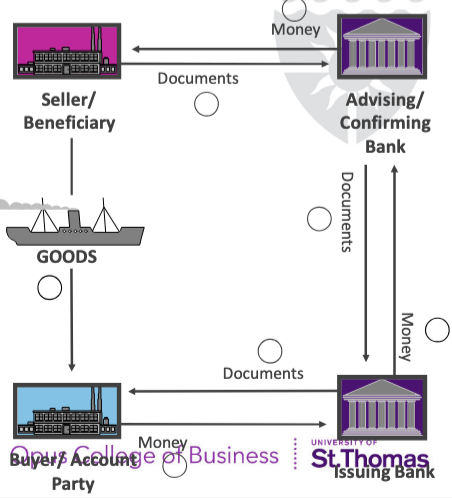
Letters of Credit: Flow of Documents & Payment
In turn, the Issuing Bank examines the documents to ensure they comply with the Letter of Credit.
If the documents are in order, the Issuing Bank will obtain payment from the Importer for payment already made to the Confirming Bank.
Documents are delivered to the Buyer to allow it to take possession of the goods.
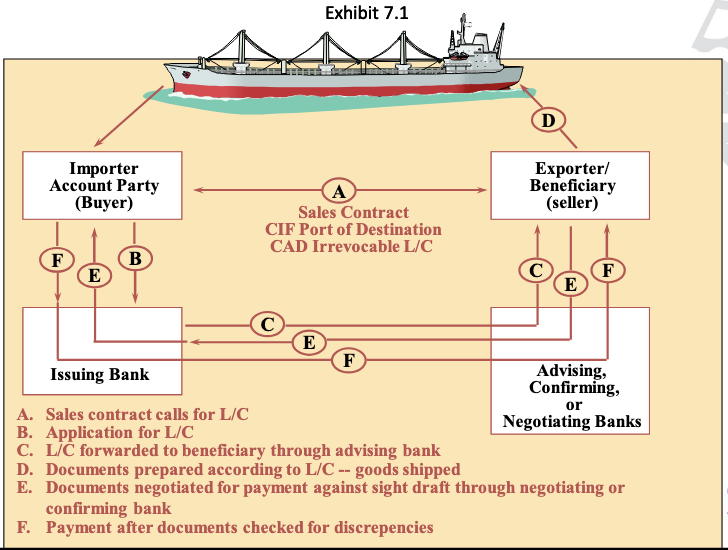
Risk Analysis: Letters of Credit
Importer
Advantages:
Importer is assured that, for the Exporter to be paid, all terms and conditions of the Letter of Credit must be met.
Ability to negotiate more favorable trade terms with the Exporter when payment by Letter of Credit is offered.
Disadvantages:
A Letter of Credit assures correct documents but not necessarily correct goods.
Ties up line of credit.
Exporter
Advantages:
An undertaking from the Issuing Bank that you will receive payment under the Letter of Credit provided that you meet all terms and conditions of the Letter of Credit.
Shifts credit risk from the Importer to the Issuing bank.
Not obligated to ship against a Letter of Credit that is not issued as agreed.
Disadvantages:
Documents must be prepared in strict compliance with the requirements stipulated in the Letter of Credit. Non-compliance leaves Exporter exposed to risk of non-payment.
Confirmed Letter of Credit
A bank, called the Confirming Bank, adds its commitment to that of the Issuing Bank to pay the Exporter under the Letter of Credit provided all terms and conditions of the Letter of Credit are met.
An Exporter would request a Confirmed Letter of Credit if it does not consider the financial strength of the Issuing Bank or the country in which it is located to be acceptable risks.
Relationship between the L/C and the Contract for the Sale of Goods
Principle of Independence
Bank is not concerned with whether goods in the underlying sales contract are conforming
Bank is ONLY concerned with whether the correct documents are presented
Examination of the Documents
The Independence Principle
Obligation of issuing bank to honor Beneficiary’s (Seller’s) Draft is conditioned solely on the Beneficiary doing what is required in LoC
UCP Art. 4 – parties deal with documents (not goods, services, other performances)
UCP Art. 14 Bank really only concerned with the appearance of the documents
Comply “on their face”?
Apparent good order
BANK MUST Honor the beneficiary’s draft
(Honor = accept or pay)
If documents not listed in the LoC produced, Bank not required to look at them
Rule of Strict Compliance
Documents presented must STRICTLY CONFORM – or are considered to be a discrepancy
There is no room for documents that are ‘almost the same’
See Exhibit 7.4 for common discrepancies page 195